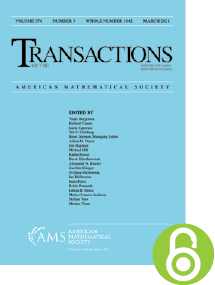Geodesic rigidity in compact nonpositively curved manifolds
HTML articles powered by AMS MathViewer
- by Patrick Eberlein PDF
- Trans. Amer. Math. Soc. 268 (1981), 411-443 Request permission
Abstract:
Our goal is to find geometric properties that are shared by homotopically equivalent compact Riemannian manifolds of sectional curvature $K \leqslant 0$. In this paper we consider mainly properties of free homotopy classes of closed curves. Each free homotopy class is represented by at least one smooth periodic geodesic, and the nonpositive curvature condition implies that any two periodic geodesic representatives are connected by a flat totally geodesic homotopy of periodic geodesic representatives. By imposing certain geometric conditions on these periodic geodesic representatives we define and study three types of free homotopy classes: Clifford, bounded and rank $1$. Let $M$, $M\prime$ denote compact Riemannian manifolds with $K \leqslant 0$, and let $\theta :{\pi _1}(M, m) \to {\pi _1}(M\prime , m\prime )$ be an isomorphism. Let $\theta$ also denote the induced bijection on free homotopy classes. Theorem A. The free homotopy class $[\alpha ]$ in $M$ is, respectively, Clifford, bounded or rank $1$ if and only if the class $\theta [\alpha ]$ in $M\prime$ is of the same type. Theorem B. If $M$, $M\prime$ have dimension $3$ and do not have a rank $1$ free homotopy class then they have diffeomorphic finite covers of the form ${S^1} \times {M^2}$. The proofs of Theorems A and B use the fact that $\theta$ is induced by a homotopy equivalence $f:(M, m) \to (M\prime , m\prime )$. Theorem C. The manifold $M$ satisfies the Visibility axiom if and only if $M\prime$ satisfies the Visibility axiom.References
- Werner Ballmann, Der Satz von Lusternik und Schnirelmann, Beiträge zur Differentialgeometrie, Heft 1, Bonner Math. Schriften, vol. 102, Univ. Bonn, Bonn, 1978, pp. 1–25 (German). MR 520178
- R. L. Bishop and B. O’Neill, Manifolds of negative curvature, Trans. Amer. Math. Soc. 145 (1969), 1–49. MR 251664, DOI 10.1090/S0002-9947-1969-0251664-4
- Armand Borel, Compact Clifford-Klein forms of symmetric spaces, Topology 2 (1963), 111–122. MR 146301, DOI 10.1016/0040-9383(63)90026-0
- SuShing Chen, Weak rigidity of compact negatively curved manifolds, Pacific J. Math. 78 (1978), no. 2, 274–278. MR 519752, DOI 10.2140/pjm.1978.78.273
- Su Shing Chen and Patrick Eberlein, Isometry groups of simply connected manifolds of nonpositive curvature, Illinois J. Math. 24 (1980), no. 1, 73–103. MR 550653 P. Eberlein, A canonical form for compact nonpositively curved manifolds whose fundamental groups have nontrivial center (submitted).
- Patrick Eberlein, Geodesic flow in certain manifolds without conjugate points, Trans. Amer. Math. Soc. 167 (1972), 151–170. MR 295387, DOI 10.1090/S0002-9947-1972-0295387-4 —, Geodesic rigidity in compact nonpositively curved manifolds. II (in preparation).
- Patrick Eberlein, Lattices in spaces of nonpositive curvature, Ann. of Math. (2) 111 (1980), no. 3, 435–476. MR 577132, DOI 10.2307/1971104
- Patrick Eberlein, Surfaces of nonpositive curvature, Mem. Amer. Math. Soc. 20 (1979), no. 218, x+90. MR 533654, DOI 10.1090/memo/0218
- P. Eberlein and B. O’Neill, Visibility manifolds, Pacific J. Math. 46 (1973), 45–109. MR 336648 W. Fenchel and J. Nielsen, Discontinuous groups of non-Euclidean motions (to appear).
- Detlef Gromoll and Joseph A. Wolf, Some relations between the metric structure and the algebraic structure of the fundamental group in manifolds of nonpositive curvature, Bull. Amer. Math. Soc. 77 (1971), 545–552. MR 281122, DOI 10.1090/S0002-9904-1971-12747-7
- Mikhaïl Gromov, Three remarks on geodesic dynamics and fundamental group, Enseign. Math. (2) 46 (2000), no. 3-4, 391–402. MR 1805410
- M. Gromov, Manifolds of negative curvature, J. Differential Geometry 13 (1978), no. 2, 223–230. MR 540941
- Ernst Heintze, Mannigfaltigkeiten negativer Krümmung, Bonner Mathematische Schriften [Bonn Mathematical Publications], vol. 350, Universität Bonn, Mathematisches Institut, Bonn, 2002 (German). MR 1940403
- W. Klingenberg, Geodätischer Fluss auf Mannigfaltigkeiten vom hyperbolischen Typ, Invent. Math. 14 (1971), 63–82 (German). MR 296975, DOI 10.1007/BF01418743 S. Kobayashi and K. Nomizu, Foundations of differential geometry, Vol. 1, Wiley, New York, 1963, pp. 179-193.
- H. Blaine Lawson Jr. and Shing Tung Yau, Compact manifolds of nonpositive curvature, J. Differential Geometry 7 (1972), 211–228. MR 334083
- Albert Marden, Isomorphisms between Fuchsian groups, Advances in complex function theory (Proc. Sem., Univ. Maryland, College Park, Md., 1973–1974) Lecture Notes in Math., Vol. 505, Springer, Berlin, 1976, pp. 56–78. MR 0412414
- Harold Marston Morse, A fundamental class of geodesics on any closed surface of genus greater than one, Trans. Amer. Math. Soc. 26 (1924), no. 1, 25–60. MR 1501263, DOI 10.1090/S0002-9947-1924-1501263-9
- G. D. Mostow, Strong rigidity of locally symmetric spaces, Annals of Mathematics Studies, No. 78, Princeton University Press, Princeton, N.J.; University of Tokyo Press, Tokyo, 1973. MR 0385004
- M. S. Raghunathan, Discrete subgroups of Lie groups, Ergebnisse der Mathematik und ihrer Grenzgebiete, Band 68, Springer-Verlag, New York-Heidelberg, 1972. MR 0507234
- Hideo Shimizu, On discontinuous groups operating on the product of the upper half planes, Ann. of Math. (2) 77 (1963), 33–71. MR 145106, DOI 10.2307/1970201
- Edwin H. Spanier, Algebraic topology, McGraw-Hill Book Co., New York-Toronto, Ont.-London, 1966. MR 0210112
- Norman Steenrod, The Topology of Fibre Bundles, Princeton Mathematical Series, vol. 14, Princeton University Press, Princeton, N. J., 1951. MR 0039258
- Joseph A. Wolf, Homogeneity and bounded isometries in manifolds of negative curvature, Illinois J. Math. 8 (1964), 14–18. MR 163262 —, Spaces of constant curvature, 2nd ed., published by the author, Berkeley, Calif., 1972.
- Shing-tung Yau, On the fundamental group of compact manifolds of non-positive curvature, Ann. of Math. (2) 93 (1971), 579–585. MR 283726, DOI 10.2307/1970888
Additional Information
- © Copyright 1981 American Mathematical Society
- Journal: Trans. Amer. Math. Soc. 268 (1981), 411-443
- MSC: Primary 53C20
- DOI: https://doi.org/10.1090/S0002-9947-1981-0632536-5
- MathSciNet review: 632536


